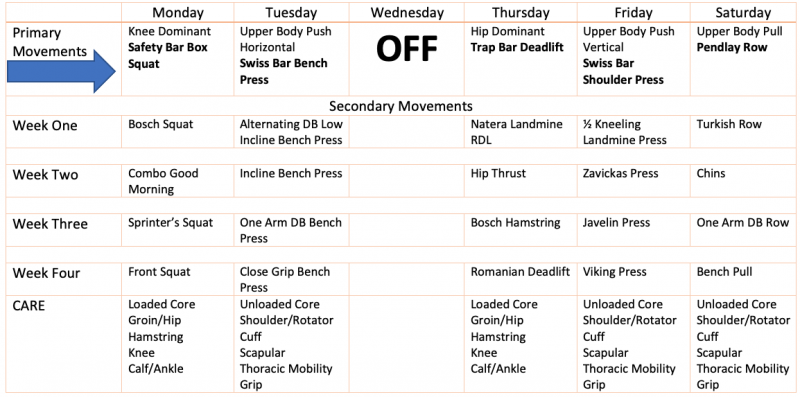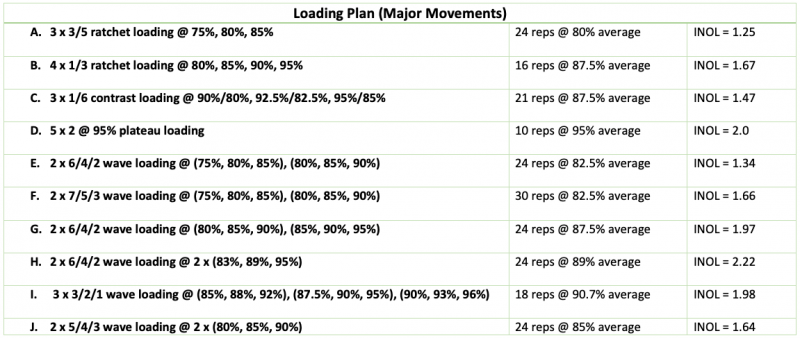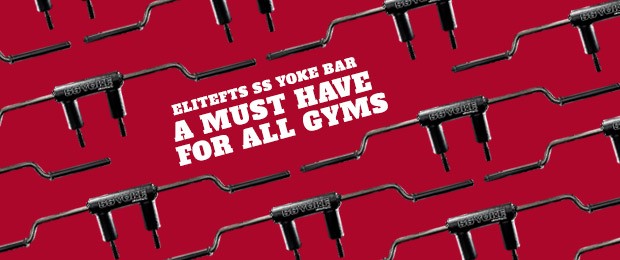
One of the brightest and sharpest minds in strength and conditioning, Peter Harding, once said to me, “Trainers complicate to profit.” It is true and proves time and time again over the ensuing years, especially now so in the digital age. Of course, the reality is that strength gains are underpinned by a solid background in training on the big compound lifts. This advice is unchanged from when Milo was a lad. Anyone who has been anything in the iron game over the last couple of millennia understands the importance of heavy and basic. The terminology has been refined somewhat with categories now referred to as Knee Dominant or Hip Dominant, but the movements themselves are important here.
In the program I am sharing with you, these movements form the foundations of your strength program. I have looked through many different sets and reps protocols (a huge mention and thank you to Christian Thibaudeau for his writings on various training protocols) and think that the ones included in this article will give you significant gains in the desired area of prioritization. The program itself is also very time-efficient, and I have coined the phrase One Big, One Small as its name. It can be used by anyone irrespective of sport or training goal to improve performance or get bigger and stronger for other reasons.
RECENT: Gym Programming Variation Across a Team
As the program's name suggests, there is one major movement, and a secondary movement supports this major movement. The tweak in this is that the secondary movement will change week to week based on the allotted sets and reps plan for that week in the program. I believe that some exercises are best suited for higher or lower reps, and this is how I have allocated the example movements. You can, of course, substitute depending on your exercise selection.
What I would like you to consider is the importance of unilateral movements. I have alternated bilateral with unilateral movements over the course of the training cycle. As a person’s training age increases it is important to introduce more unilateral movements into the training program to ensure that imbalances between limbs is corrected. There is evidence that unilateral training increases motor unit activation. When training for sports performance, the transfer to the field of play is of the highest importance, and there is much evidence of significant positive transfer when using unilateral movements. By alternating the movements each week, there is no significant break-in period, which may cause delayed onset muscle soreness and negatively impact the other elements of the programming.
The other key ingredient in this type of programming is the use of isolation movements to conclude each workout which will assist in injury prevention (prehabilitation) or to regain full strength in a damaged body part following an injury (rehabilitation). I have named this the CARE program, CARE being an acronym for Core Accessory Rehab Exercise program. Using the CARE program, select different movements each training day that reflect the movements being trained on that particular day as listed in the example week plan. A full list of possible movements is included at the end of this article; all these movements can be seen on YouTube clips for correct movement performance.
Each program will take around 30–45 minutes to complete. If you wanted to, you could combine the upper body push and pull movement together and use a superset style of training to increase intensity and decrease overall training time, depending on your schedule. I like the “micro-dosing” approach to training since I work in a sport where there are always other aspects of performance that need to be trained. It is important to balance all aspects of training as we work to a performance outcome each week in-season— not just trying to get bigger or stronger as the only priority.
One Big, One Small
Example Week Plan
Accessory Movements
- Week 1: 4 x 8 - unilateral
- Week 2: 4 x 4 - bilateral
- Week 3: 4 x 6 - unilateral
- Week 4: 4 x 2 – bilateral
Loading Plan
Strength
- Week 1: C or E
- Week 2: H
- Week 3: B
- Week 4: I
Size
- Week 1: A
- Week 2: C
- Week 3: E
- Week 4: D
Combination Strength & Size
- Week 1: A
- Week 2: B or F
- Week 3: C or E
- Week 4: D or G or H or I
Core Accessory Rehab Exercise (CARE) Program
2 x 10 reps on each, unless stated in the list below
Loaded Core (3 x 5): ½ Turkish Get Up, Windmills, Rollouts, Suit Case Dead Lift, Combat Twist, Weighted Sit-up
UnloadedCore (3x15): Dead Bugs, Sprinter’s Sit-up, Plank Variations, Hanging Leg Raises
Shoulder/Rotator Cuff: Incline YTI’s, Bottom-up KB Press, Cuban Press, DB Scarecrow, DB L Raise, Lying Internal/External Rotation, Supine T Rotation
Scapular/Posterior Shoulder: Scap Push-ups, Scap Retraction, Face Pulls, TRX Scap Push up, TRX Scap Retraction, Iron Scap Series (Archer, Pulldown, Tiger walk, WY Negative, Snow Angel, Bear Hug, ATYT)
Neck: Iron Neck, Wrestler’s Bridge 2 ways, Neck Planks 3 Ways, Band Look Away, Plate Flexion/Extension
Groin/Hip: Copenhagen Planks, Crab Walks, Clams, Askling Slider Lunge, Yoga Series (Inchworm to Plank, Right Step Then Back, Left Step Then back, Down Dog, Up Dog, Inchworm to Standing), High Hurdle Series
Hamstrings: Landmine Negative Accentuated RDL, Nordics, RDL Drop & Catch, Single-Leg Hip Thrust, J Curl, TRX Hamstring Curl, L Protocol (Extender, Diver, Glider)
Grip: Captain’s of Crush Grippers, Dog Bone Chins, Grandfather Clock Chins, Grenade Chins, Towel Chins, Rope Chins, Thick Bar Chins/Pull-ups
Knee: Single Leg Squat to Bench, Terminal Leg Extension (last 15 degrees), Petersen Step-up
Calves/Ankle/Foot: Single Leg Calf Raise, Skipping, Prowler® Push, Inversion/Eversion with Band, Single-Leg Hops, Single-Leg Landing on Bosu Ball, Toe Yoga, Intrinsic Foot series
Thoracic Mobility: Overhead Squat, Turkish Row, Band Pull Apart, Cat to Camel, Kneeling Banded Downward Rotation













3 Comments